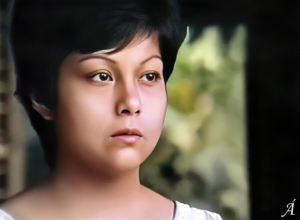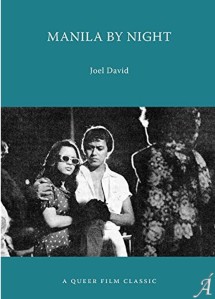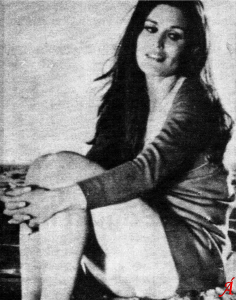Underground, in the Heat of the Night
The kind of creepers offered by a special type of picture-stories are keen enough to distinguish the adults from the kids, sometimes. Once in a while a couple of runts browse through the stuff, maybe meaning to use the alibi that they thought it was the nicer kind, though everyone knows how quick kids are today with doubletalk. Couldn’t blame them, I guess – once you accede to bending down that low, literally even, I’ll bet your (alleged) normal youthful reputation you won’t be able to rise as quick. They’re picture-stories all right, spread out along with the more legit weeklies and song-hits mini-mags in the so-called capital city’s armpit and the country’s densest district, Quiapo or Po-quiaps or just plain (and vulgarly) Poks in kanto-boy and jeepney-driver lingo – nearly the only place in the country where an estimated minimum of two million souls in harried and hurrying bodies pass through, pass by, pass over and even under, and occasionally pass out in the course of a regular working day.
11011But those picture-story magazines, which we continue to call komiks despite the humorless attitude some sectors have adopted toward them, will be found, true to their nature, underground and in the heat of the night. At the Quiapo pedestrian underpass, which can be entered from among seven directions along the main thoroughfare just before Quezon Bridge, and during the hours between sunset and sunrise, vendors begin by arranging on the floor the safe items, reserving a middle section for the bolder versions once the underpass crowd composition maturates – that is, becomes on the average older and more masculine – to allow for easy retrieval in case of raids. With all the foolhardiness that youth and curiosity occasionally bestows, I descend the entrance alongside the recently renovated church, where the sellers of various herbs and amulets are packing up their wares in acknowledgment of the less spiritual nature of night life, and circle the central savings bank, fitting symbol of material aspirations even on the subterranean level, to pick out representative titles from about a dozen outlays.
11011One of the stands, or rather seats, happens to have the only male vendor around at the time, so the prospect of frank discussion doesn’t seem so embarrassing; he even opens a conversation by suggesting some of the better issues and offering discounts. Lito, as he introduces himself, has been in the trade (of selling komiks, that is) for almost exactly three years or, as he pertinently puts it, “mula nung assassination ni Ninoy.” The association by which he reckons his shift from carinderia operations becomes more germane when he explains that he started out by selling “Mr. & Ms. at kung anu-ano pang bawal nuon na hindi na ngayon. Siguro swerte ko na yung pagtinda ng babasahing hindi pa tanggap ng mga naghahari sa ’tin.” He admits that the “bold” versions he resorts to as a matter of necessity. “Ito lang talaga ang pinaggagalingan ng kita namin. Kung karaniwang komiks o magasin o song-hits lang ang aasahan ko e walang mangyayari.”[1]
11011I begin to get an idea of the economics involved only after skimming over the wares’ cover prices: the song-hits mags begin at ₱1, regular komiks at ₱2, and neither goes beyond thrice the rates, while the soft-core versions begin at ₱3.50 and reach as much as … ₱25! “Siyempre me tubo na kami agad,” Lito explains. “Nagkakaiba na lang sa kung alin ang mabenta.” Past issues can be bought on retail at bargain prices, which means they get sold for much less than their cover prices. “Yung nabebenta naming sa tigpipiso, nabibili namin ng 25 sentimos isa.” Moralists may argue that the profits are not that clean, and Lito agrees, on a purely monetary basis. “Wala ngang upa sa lugar na ginagamit, napupunta naman sa ‘pakikisama’ yung kita namin minsan. Pero mas matipid pa ’yon kesa kung ma-raid kami: ₱160 ang multa, umaabot ng ₱200 ang piyansa, napakalayo pa ng kulungan, sa Fairview, kaya yari ka rin sa pamasahe.” Either for profit maximization or for additional security, or more likely for both reasons, Lito claims that “magkakamag-anak kaming mga nagtitinda ng komiks dito” – maybe a literal reality, although just as likely a euphemism for the necessity of forming close-knit alliances against the free-for-all from several sides that a non-legal business regularly attracts.[2]
11011As to the items in question, much has been made of the case that both publishers and guardians of morality claim to have won over a year ago. A semi-legitimate status has been granted the more established outfits by allowing (or requiring, depending whose point of view you take) them to publish staff boxes; an obvious drawback here is that, as in the movies, such items may not go, as we love to say and sometimes do, all the way. Recent uncredited items such as Checkmate (₱25 each, all photos with word balloons) and Senswal (no price indicated, picture stories and features in song-hits-size format) get away with more than just the apparently allowed penetration scenes. Yes, María (Clara), they do have close-ups, as graphic as pen-and-ink or offset photography could allow, of genitalia in coital entanglements.
11011And yes, the relatively milder ones contain sexual couplings, or at the very least total nudity, as staples for each and every picture story and feature or narrative, which runs for up to five pages. Imagine a minimum of thirty pages per komiks issue, and titles running up almost the same number, and frequencies at weekly, fortnightly, or, at the rarest, monthly intervals – and you might find yourself reaching for a list of litanies or ejaculations (pious, if not anything else). The Man of La Mancha to which faithful beneficiaries like Lito play Sancho Panzas in this endeavor appears to be a certain “Atty. Amador E. Sagalongos,” publisher of about a half-dozen titles including the celebrated Sakdal and Tiktik and their spinoffs Tiktik Bold, Erotik, and so on. In certain titles he has run installments of the court ruling on the earlier mentioned obscenity case, while in most others he prints, under his by-line and with his picture, erotic verses that aspire to some measure of political relevance by castigating the previous regime or hailing the present dispensation.
11011In fact, for the rest of what Americans would call blue (or the Japanese, pink) publishers, social consciousness is the rule rather than the exception: certified Pinoy phenomena like overseas labor, illegal emigration to America, the presence of foreign military bases, double standards for domestic sexual practices, problems in premarital pregnancies and contraception, as well as the universal concerns of prostitution and poverty – all these and more define local erotic reading fare rather than do the psychological or anatomical fantasies found in foreign counterparts. From the twenty-or-so titles I bought, I was able to count only one instance each of a picture story that dealt with impotence, incest, bestiality, and urolagnia (translated on a Tiktik cover as “pantasiya sa ihi”). Homosexuality seems to be a different, er, affair altogether. Apart from specialized titles such as Silahis and Macho (another Sagalongos publication), there are stories or features in every other “straight” title that dealt explicitly with the subject.[3] Feminists may perceive another attempt at discrimination, but the male condition is almost always presumed in these pages to be more permanent in nature than lesbianism, in which the errant lasses get “converted” in the end by some guy or other. The incursion of this singular social taboo into the supposedly heterocentrist milieu of erotica may after all only be a throwback to the goings-on aboveground, where at this time of the night the members of the so-called twilight sex earn their epithet (and sometimes their keep) by cruising about, mostly on foot, for prospects for carnal communion, and where mainstream comedies now allow effeminate gay-male characters to retain their flamboyance all the way to the end but insist on tomboyish women capitulating to the dictates of (to coin a should-be disparagement) reproductivist patriarchy.
11011Whether gay or merely happy, the new breed of erotic komiks has come a long way from the BTS or “bedtime stories” type that used to flourish in the neighboring Recto-Avenida area during the late sixties and seventies. I remember mimeographed or photocopied issues going for the equivalent of a day’s allowance in high school, and heave a sigh – of gratitude, honest – from the thought that today’s social misfits would not have to spend proportionately as much as we did then. The advantages of legitimization go beyond consumer relief. According to Lito, “Natutulungan kaming mga vendors nung mismong mga publishers kung sumasabit kami sa batas.”[4] The publishers, writers, and artists themselves occasionally print declarations of war against government censorship on the very pages of their publications, although their defenses lie within the realm of social relevance, as pointed out earlier, rather than the standard Western reliance on artistic merit.
11011Again, as in the instance of cinema, I couldn’t help wishing that genuine literary expression could find its way into some of these items, so that their redemption, elitist as it may sound, will be complete.[5] Before that could happen, of course, the mainstream komiks publications may have to upgrade their quality, probably by infusing inspiration from the allied medium of film, rather than contributing mayhem, as they are wont to do, in the opposite direction. Thenceforth we may be able to watch the benefits trickle down the likes of Dalaga and Pic, the gamer Game, Lips, Hot Legs, New Boobs, Playmate, Intimate, Swank, For Gents Only, and the Sagalongos titles, and even the truly illegal items that refuse to identify the people behind them. Come that time, we may not have to envy those who check out a public library just to realize that some in-your-face rags might just be more sensible but still profitable picture stories, worthy of regard as vital and lasting contributions to the national heritage, you betcha.
[First published October 16, 1986, in New Day]
Notes
[1] “Mr. & Ms. and other items that used to be dangerous to be identified with. I guess it’s just my luck to sell reading materials which don’t sit well with authorities.” “This is actually where we derive our income. If I rely on ordinary komiks or magazines or song-hits items I won’t be able to survive.”
[2] “Of course it’s sure-fire profitable.” “The difference lies in terms of which items sell more.” “What we can sell for a peso each, we could purchase at 25 centavos.” “We don’t have to pay for rent for the space we occupy here, but ‘cooperation’ takes a toll. We just think it’s cheaper than the consequences of a raid: the penalty’s ₱160, bail could reach ₱200, the jailhouse is too far, at Fairview [a suburban district], so you also wind up spending a lot for transportation.” “We komiks vendors are related to one another.”
[3] “Fetishizing urine.” “Silahis” and “macho” also happen to be code words in Philippine gay lingo, referring to bisexual males and gay-available straight men respectively.
[4] “We vendors are helped by the publishers themselves whenever we run afoul of the law.”
[5] A couple of colleagues who became scriptwriters for world-renowned films, as well as a university instructor (who sadly experienced oppression, from left-leaning seniors who should have known better, when she was outed for her experience in erotica authorship) were some of the few people I have known to engage in the profession.
Back to top
Return to The National Pastime contents
In My Father’s House
Playwright Elsa Martinez Coscolluela (trans. Raul Regalado)
Directed by Tony Mabesa
As an extra-active in-house editor for the Experimental Cinema of the Philippines (ECP), I was once assigned to the screening committee of the third (and last) scriptwriting contest. Only two winners were chosen, both of which were endorsed to the board of judges by none other than yours truly. The inside news, however, was that the preferred top-prize winner was disqualified on a double technicality: not only did the script proposal require a more-than-modest budget (for which the consideration of a few other entries would have to be set aside), it would also have duplicated the themes and setting of the first ECP production, Oro, Plata, Mata. Flashforward to the present, when one of the contest’s judges, out of a refusal to allow the ECP’s demise to negate its noteworthy aims, convinces the writer of the said screenplay to revise her work for the medium out of which he has made a lifetime career: the theater.
11011Like Oro, Plata, Mata, In My Father’s House has seen rough commercial sailing. And if we take an optimistic course and regard its ultimate destination as the celluloid product it was originally intended to be, then its odyssey from judges’ favorite to future film product through the legitimate stage may well be one of the most unusual transitions in contemporary local culture. To be sure, In My Father’s House stands several cuts above the disturbing succession of stage plays that actually aim for ultimate preservation on film (or even just video, via television). Our local playwriting contests have much to answer for in this case; works are judged according to how they read, not how they may be performed, and in several depressing instances writers who employed misappropriated cinematic techniques tended to impress their respective jurors, who should have known better.
11011I hope I don’t sound too condemnatory in pointing out that these cinematically obsessed playwrights were in a sense the predecessors of our so-called independent film practitioners, who dabble in media or formats apparently alien from the mainstream movie industry, but actually aim for stable long-term employment within (as evidenced in their output as well as the number who grab too eagerly at opportunities for commercial film assignments). Nothing wrong with having to survive, I submit, except that sometimes the struggle has resulted all too often in a hierarchism of media forms and assignments: this here’s a mere short film (or play or article), it could get me some attention so I could get away with a little slothful artisanship – after all, this isn’t the big time … yet.
11011Hence my sense of appreciation and gratitude for In My Father’s House. The play’s film-script origins are still detectable, particularly in the inordinate number of blackouts (equivalent to the film medium’s fadeouts), but the whole presentation has amounted to a cherishable and well-grounded discourse on the dehumanizing effects of war on the best intentions of those caught up in it. The story details the plight of a Negros-based family, chronicling the members’ confrontation with the realities of the Japanese occupation from the start of the war until the impending liberation (or, as per Renato Constantino, the re-occupation) of the country by American forces. The siblings find themselves in opposing camps, though hardly by the passive nature of their characters: one realizes firsthand the effectiveness of the enemy’s brutality and decides to collaborate to preclude whatever further harm may be committed against his loved ones, while another is outraged by the very same reports, though from a comfortable distance, and decides to join the guerrilla movement.

The rural gentry confronted by the tragic divisiveness of World War II, in Elsa Martinez Coscolluela’s screenplay-turned-stage play In My Father’s House (1987, dir. Tony Mabesa).
11011The worst that the invading forces visit upon the family is the occupation of their residence by an officer, who is never seen; instead he is represented by his clown of a deputy. In the end the tragedy that befalls the family is directly caused by the guerrilla offering to save his collaborator-brother but inadvertently betraying him to a rival unit. An acknowledgment of classical traditions pervades the entire production, with deaths occurring offstage and the action being continually summarized and assessed by the survivors. The only onstage tragedy, the suicide of the fiancée who could endure repeated rape by the Japanese officer but not the contempt of her guerrilla-lover, serves to maintain the essential context of the drama – i.e., that the enemy, no matter how harmless in appearance, is capable, on a near-bestial level, of the civilized but still-harmful actuations of his captive hosts, and that in a sense this doesn’t make him any different from them after all.
11011Such perceptions about the wartime behavior of the bourgeoisie could only have come from finely observed and fully felt experience, and whatever the arguments against the dangers of romanticism, there ought to be room for such theses in the first place, the better to form possible answers from. In My Father’s House can be taken on its own, with the reservations (and then some) I already mentioned, but it can also be appreciated as a creative inspiration’s long (and unfinished) journey to realization. I suggest viewing it as a companion piece to Oro, Plata, Mata, with the notion of the voyeuristic peek into the bourgeoisie’s not-so-discreet charms this time replaced by an Areopagitica of sorts, a plea for tolerance and soberness from a people who are still figuring out what to do with themselves.
[First published December 2, 1987, in National Midweek]
Back to top
Return to The National Pastime contents
Si Tatang at mga Himala ng Ating Panahon
Ricardo Lee
Quezon City: Bagong Likha Publications, 1988
It’s been a long wait – three years – since something that can remotely be called a local film book got published, and even then the pickings were pretty slim, mostly confined to anthologies and published screenplays. Now one of our more active film-and-print crossover writers, Ricardo Lee, has come up with his fourth book, and it happens to be another anthology that happens to include another screenplay. The first thing that anyone can say about Si Tatang at mga Himala ng Ating Panahon, however, is that it isn’t, strictly speaking, a film book. Aside from the film script and a few articles on local movies, Si Tatang comprises the author’s short fiction, all except one dating to as far back as the early seventies.
11011Si Tatang is also packaged with some pretty formidable raves from just-as-formidable names in local film and literature. Amazingly, though the comments seem to have been made with Lee’s specific accomplishments in mind, the book itself adds up to more than what one may be led to expect. This it accomplishes largely through the merits of “Kabilang sa mga Nawawala,” Lee’s latest piece of writing, classified in the book as fiction but actually a summation of the author’s thematic and stylistic concerns during the inordinately long spell when he forsook short-story writing for scriptwriting and journalism. “Kabilang” (at novelette-length the longest of Lee’s short fiction) will be capable of enduring more discussion than anything Lee has ever done before in the short-fiction genre, but as earlier stressed, its arrival in the book, as in Lee’s career, is itself worthy of careful consideration.
11011The build-up toward “Kabilang” is managed through a deliberate breakdown of classification. Journalistic pieces alternate with fiction, and even particular approaches vary from piece to piece. As if to literalize the point, Lee’s “Mga Batang Lansangan” series is evenly spaced between most of the rest of the book. This arrangement demonstrates that, superior as Lee’s earlier achievements in fiction were, it was actually the practice of journalism that served to provide him with the ideal laboratory for experimentation. His evolution in this regard is paralleled by the experiences of new journalist Tom Wolfe, who lately has also been turning to fiction after practically a compleat career in factual writing.
11011Where Lee outfoxes Wolfe is in the appropriation of magic-realist devices that come as a genuine surprise, appearing as they do (and as they are wont) from seemingly out of nowhere. That is, if we take the book as a faithful representation of Lee’s writing. Actually those who’ve been following him closely enough to observe even his work in film will have had enough warning of where he was leading himself to. The selection of Himala then assumes red-herring status in this anthology; relative to other Lee-scripted films, it’s a conventional achievement whose contributions lie in extra-literary aspects, specifically the circumstances attendant to its production and Nora Aunor’s performance (both of which are appropriately played up in production notes).[1]
11011More forward-looking works would be Lee’s previous book publications, especially the screenplay of Moral, plus other unpublished (but fortunately produced) scripts, particularly Sinner or Saint and Private Show. Of course this only means that there ought to be more film script publications done, but then this applies to a whole lot of other writers, not just Lee, and meanwhile Himala in the context of Si Tatang can be taken as proof that the author could be capable of above-average competence in disparate writing formats. The journalistic pieces evince more diversity and, most important, an abiding populism that heightens whatever the stylistic and even politicized interests of the moment happen to be. Journalism, by the very transience of its nature in general, has proved most productive for innovators like Lee; the challenge of holding responsibility for correspondences in real life supplies a discipline that could never have been available in fiction.
11011Hence a return to imaginative writing, as Lee does in “Kabilang sa mga Nawawala,” could only be logical enough in its evolution, yet indicative of more miracles up ahead. Outside of Si Tatang, “Kabilang” arrives alongside a revivification of stylistics in Philippine literature in English, but none too late for either current appreciation, or eager anticipation of what writers, those who’ve transcended trends, genres, and even language, will have to offer next.
[First published February 8, 1989, in National Midweek; excerpted in Ricky Lee’s Si Tatang at mga Himala ng Ating Panahon: Koleksyon ng mga Akda (Quezon City: Writers Studio Foundation, 2009), page 11]
Note
[1] Upon compiling a comprehensive bibliography of Philippine film-book titles, I was floored to discover that, after over a half-century of fits and starts, the still-continuing contemporary wave (more like a tsunami) actually began with several volumes devoted to Nora Aunor. See “The Aunor Effect in Philippine Film Book Publications” in Amauteurish! (January 28, 2020).
Back to top
Return to The National Pastime contents
Unlike in developed countries, local television is being treated as an extension of the film industry. The logical and historically validated trend, of course, is in the opposite direction, so either the industry, with the necessary government support, shapes up, or TV eventually bears down. The other audiovisual medium, theater, will increase in importance once film is regarded as more than just a national pastime: where TV (via video) provides technological familiarization, theater will be hard to beat when it comes to supplying highly developed and properly oriented talent.
11011Print media ought to be the best venue for critical discourse of all kinds, including film – except that mainstream dynamics arrogates unto politics the status of serious object of study, and unto culture the role of jester. No doubt culture, film especially, can excel in this function, but it is also capable of raising issues as grim as they come, whereas politics is hardly ever constructively entertaining, unless and until all other options have ever been exhausted.
11011At the moment broadcast media are serving as popularizers for film awareness, which makes print the equivalent of discursive level for this activity. The manner by which all the other major forms of mass media treat film regularly, but not one another and not in the other direction (film regularly treating other media) upholds, like it or not, the primacy of filmic discourse in media and the arts, a stature that will be supplanted not by any of the other available forms, but by some possible future advancement in media technology.
[First published October 24, 1990, in National Midweek]













 ORCID ID
ORCID ID 